'Blue Planet II': How an octopus outsmarts a shark
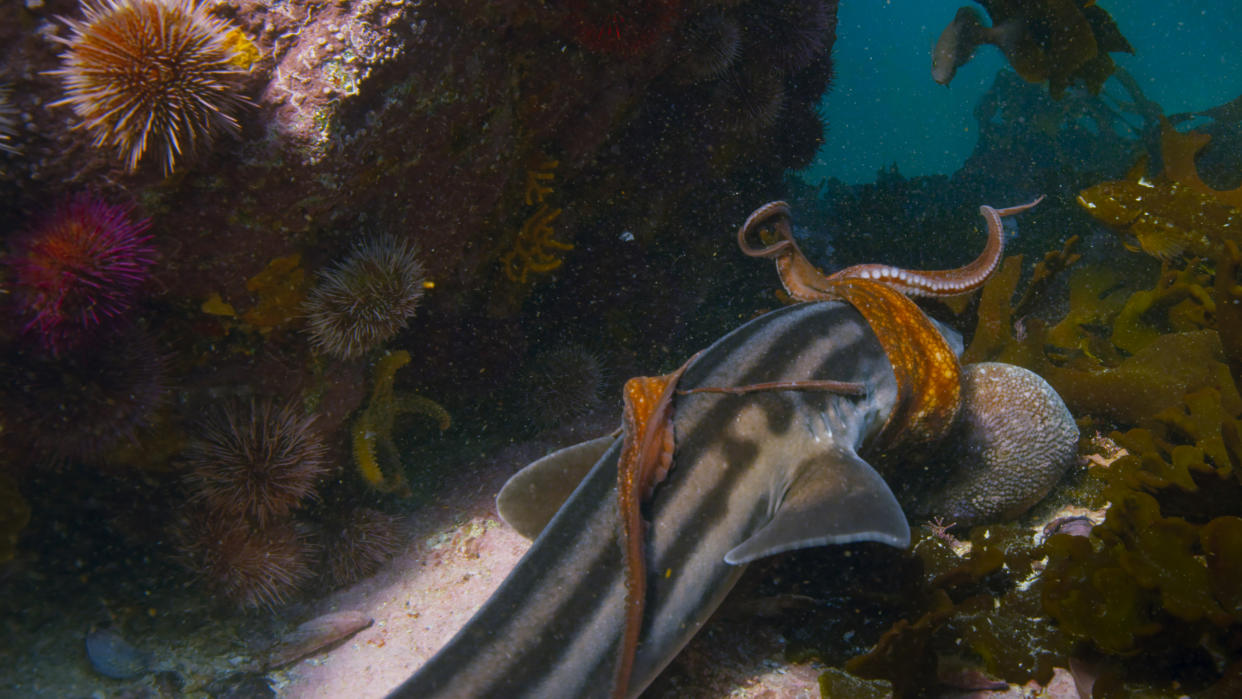
We’ve seen a lot of amazing things in the first four weeks of BBC America’s Blue Planet II, but the Feb. 17 “Green Seas” installment has an octopus that episode producer Kathryn Jeffs likens to Sherlock and a spider crab she thinks of as Jon Snow.
The former sequence takes place in a South African kelp forest, where the hunter, a common octopus stalking a crab, suddenly becomes the hunted. A pyjama shark, which is an expert at hunting in the undergrowth, is just small enough to reach into the crevice where the octopus tries to hide. It grabs hold of the octopus and shakes it violently — until the octopus slips its tentacles into the shark’s gills (as seen in the photo above). The shark can’t breathe, so it has to let the octopus go.
This octopus then does something that had never been filmed before: she (yes, it’s a she) gathers shells with her tentacles and creates an armored disguise — hiding in plain sight, as narrator Sir David Attenborough says.

The shark ultimately figures out the ruse, but the shells confuse it long enough for the octopus to escape.
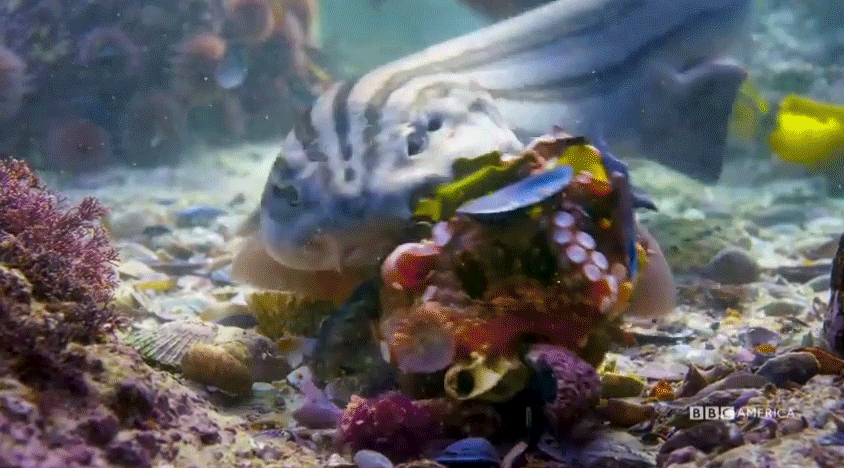
Jeffs has long considered octopuses one of her favorite animals because they’re so wily. “You have this impression that they just have this sort of alien intelligence that we couldn’t perhaps understand, but seeing this footage was just mind-blowing because then there’s proof,” she says. “There’s this phenomenally clever animal that’s just doing everything it can, using its wits to survive against quite a ruthless predator.”
As viewers will learn in the making-of segment that ends the episode, the attack was particularly upsetting for cameraman Roger Horrocks and naturalist Craig Foster, who allowed Horrocks to follow alongside him for months in search of an octopus on the hunt. Foster uses the tracking skills he mastered in the Kalahari to try to understand the lives of the animals living in the kelp forests, and after six years of daily morning dives, he knows individual octopuses and their personalities. “Because they got to know this octopus so well, their hearts were in their mouths when a shark did actually attack her. Were they about to see their little star predated?” Jeffs says. “The behavior with her pushing her arms through the gills really was quite a surprise to us all — certainly a surprise to them, I think. They thought she’d had it. She fought back and escaped, and it’s quite amazing.”
When you watch the sequence Saturday, the music from composer Hans Zimmer and the team at Bleeding Fingers might remind you of the Benedict Cumberbatch-starring Sherlock. That’s intentional. “She was so clever and had such a lovely way of moving through her environment with such stealth and intelligence that she reminded me of Sherlock,” Jeffs says. “That was actually the approach that we made in the edit as we were putting this piece together. Octopus have such powerful observations, and that’s how they’re constantly making exceptionally important decisions about when to move, where to move, how to move, to move with the movement of the kelp. They’re constantly observing their surroundings and adjusting their bodies and their postures and their colors as they’re moving. A lot of that comes from an innate behavior, but there’s certainly an intelligence there as well. She really was Sherlock to me, and so we wanted to bring that across.”
Game of Thrones‘s Battle of the Bastards, meanwhile, was on Jeffs’s mind when it came to the spider crab sequence. Hundreds of thousands of the giant spider crabs march together in Australia because there’s safety in numbers. When it’s time to break out of their shells so that they can grow, it’ll take days or even longer for their new shells to harden — leaving them vulnerable to predators. “For me, our hero crab was always Jon Snow in that incredible battle scene,” Jeffs says. “So that was absolutely one of the focuses as we were cutting that scene — this poor individual just kind of clamoring to survive in this mass of bodies.”
A tease of a few other memorable moments in this Saturday’s hour…

Giant cuttlefish mating: The Blue Planet II team worked in South Australia with cuttlefish scientist Alexandra Schnell, who’s been studying what Jeffs terms “this quite incredible, tumultuous scene of amazing behaviors.” When a large male has its eye on a female that’s clearly over him, a smaller male may take it upon himself to mute his coloring and “tuck in his arms” and pose as a female — so he can swim right up to the larger male and then to the female, with whom he’ll mate. What fascinated Jeffs more than how sneaky the battling males can be is the role females play in deciding their partners. “They were almost giving the brushoff to certain males and allowing others to approach, and it was all about this little white stripe signal that they were using,” she says. “So that was absolutely the story that we wanted to tell.”
It was tricky for the camera team being surrounded by the largest mating aggregation of any cephalopod in the world and trying to spot that particular signaling (a white stripe on her side means no). “Because of course it’s not all females that are doing this all the time,” Jeffs says. “You’ve just got to find the right scenario where the right individuals are interacting in that way. It was only when the cameraman started to rise above the action and he was getting shots looking down on the cuttlefish that he started to actually pick up on this one female who was using the signaling and then was able to hone in on the trio. It was fantastic to see these individual animals really having an impact on what was happening around them.”
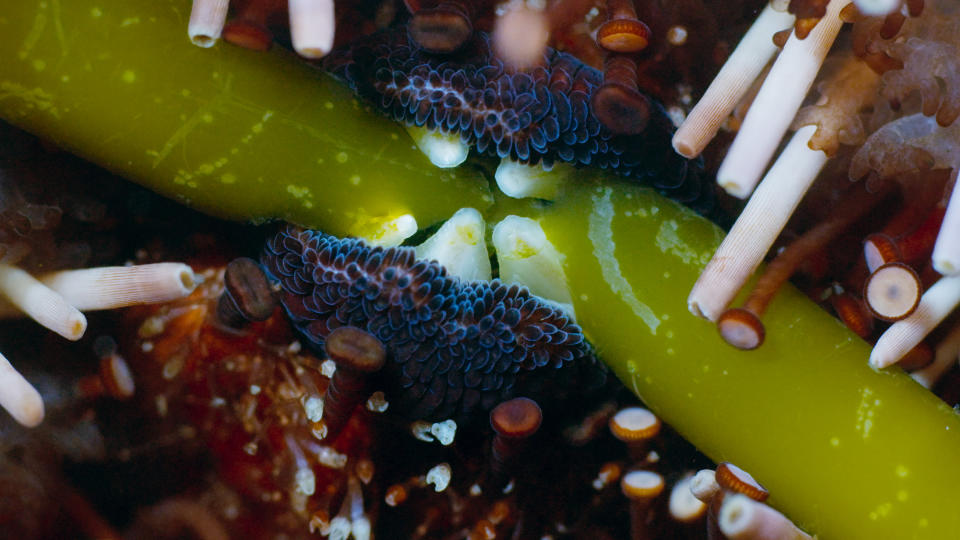
Sea urchins eating: Sea urchins have tough, self-sharpening teeth — and when urchins move in as an army, they can decimate a kelp forest and leave it barren. Close-ups like the one above are mesmerizing. “Obviously when you’re looking for very close-up macro shots like that, you are moving into using special filming tanks,” Jeffs says. “So what we tend to do is we get the big wide shot in the field, in time-lapse, then we take a number of the individuals into captivity [for a short period of time]. They are eating machines, so they are very happy to keep munching away on the kelp. We use special, thin filming glass, and that enables us to get those very tight macro shots, and then we can release the urchins back into location.”
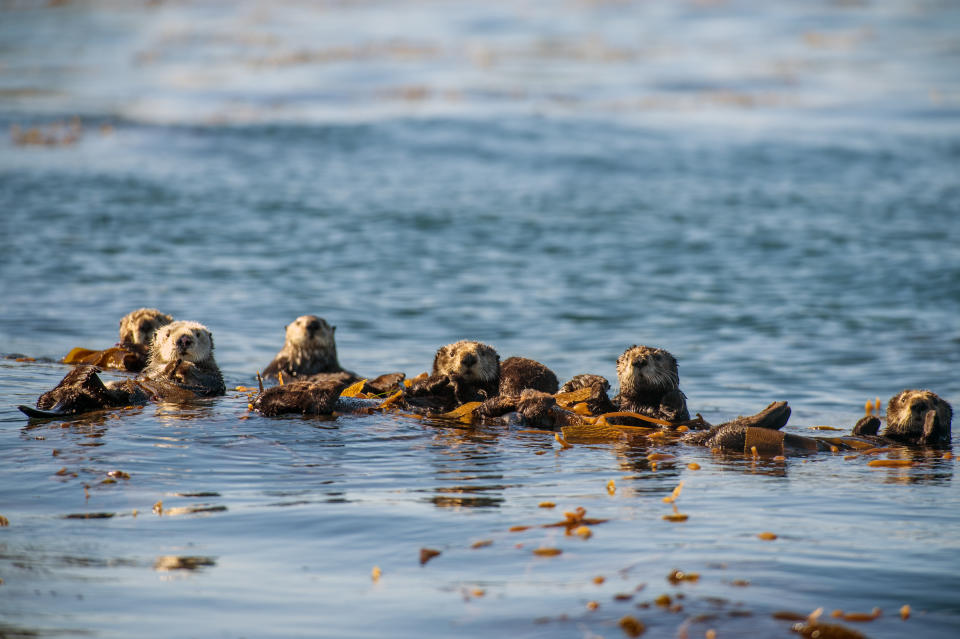
Sea otters rafting: Sea otters, it turns out, eat urchins, which helps keep them in check in the kelp forests off America’s Pacific coast. What may surprise some people: sea otters almost went extinct. “It was only because of them being protected that their numbers have bounced back,” Jeffs says. While those numbers are going down again in some areas, the team was able to capture gorgeous aerial shots of a large group of otters huddled together, or rafting — a sight not seen for over a century. “It’s intriguing, because you wonder, ‘Is this the kind of scene that would’ve been seen up and down the American coastline not that long ago? If we continue to protect them, might those kinds of raftings be seen again in the future? And what impact will that have on the kelp forest?’ Because you can see quite clearly that when otters are around, the diversity of animals in the kelp forest goes up, and the kelp forests themselves can expand, so there is that wonderful beneficial relationship.”
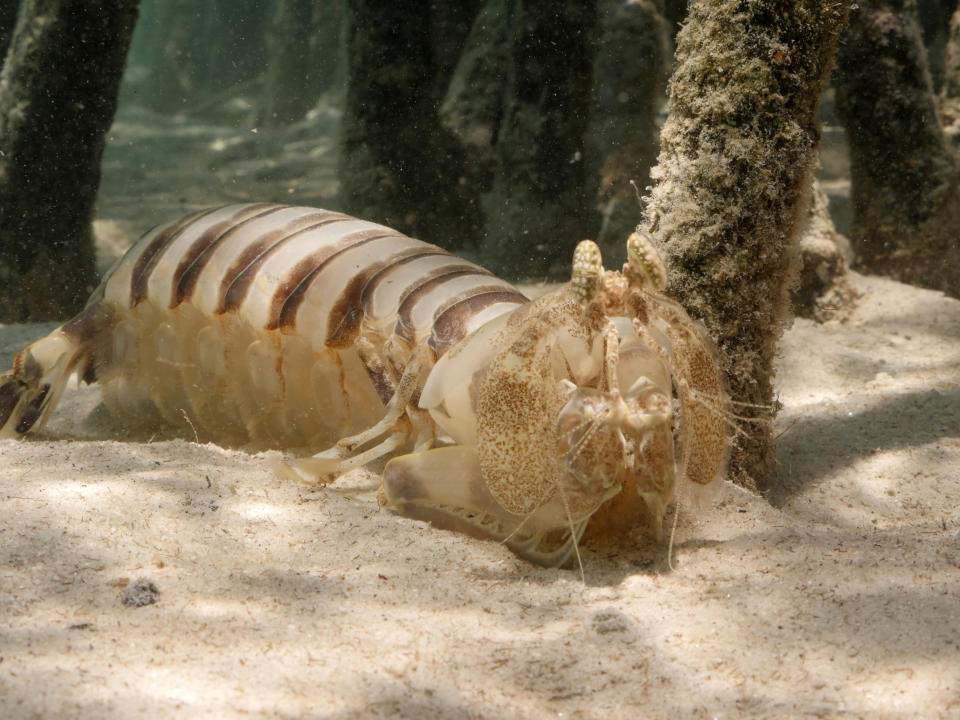
Zebra mantis shrimp ghosting: Jeffs admits this story is “quite dark, in a way.” The team worked with biologist-cameraman Alexander Vail, who studies these large shrimp hunting in the mangrove areas around Australia’s Lizard Island. For many months, he put tiny little remote cameras out into the field, next to their burrows, and he was able to capture the hunting behavior seen in the episode (a sneak attack from below similar to the bobbit worm in Episode 3). The male collects food for its mate, since the female stays in the burrow and focuses all her energy on her eggs. It seems like a good plan. But the team was also talking with scientist Roy L. Caldwell in the States, who told them how these shrimp mate for life, but that it doesn’t always run smoothly — sometimes a male leaves his partner, of maybe 20 years, to shack up with a larger female who’s been abandoned by her life partner. “Having worked with the mantis shrimp in the wild, Alex was able to identify particular couples that were hunting and that he’s been able to film well. So we were able to capture those, again for a very short period of time, and bring them into filming burrows. Then, as we were releasing them, we were able to get shots as well in order to tell the story.”
Planet Earth: Blue Planet II airs Saturdays at 9 p.m. on BBC America.
Read more from Yahoo Entertainment:
The most heartbreaking sequence in ‘Blue Planet II’: A pilot whale mourning her calf
The most terrifying sequence of ‘Blue Planet II’: The Bobbit worm
Why ‘The Deep’ episode of ‘Blue Planet II’ is the one you can’t miss
‘Blue Planet II’ premiere: Bird-eating fish and 5 more sequences you’ll be talking about


